
Funeral Customs
Each faith tradition has its rituals, customs, and norms for the end of a person’s life and the celebration of that life. We will call them "customs" for most of this article. The customs of one’s faith tradition can provide comfort and guide to navigating the early days of grief. Each faith tradition and those who do not identify with a particular faith tradition have varying beliefs surrounding death and grief. These customs are often based on documented text or oral tradition from that faith tradition, and some are based on cultural norms in which the religion is practiced.
The U.S. has a diverse religious makeup. In the recent census, the largest growing population was those who do not identify with any particular faith tradition. Those practicing Western Christianity (Catholic, Protestant, and other denominations) make up more than half the population. Those who practice Judaism, Islam, and other faith traditions are a smaller percentage of the overall population. Let’s look at some of these customs through the lens of faith traditions.
This content was prepared by our friends at Faith & Grief Ministries and covers some of the most common faith traditions. We will continue to add to this content.
Christian - Catholic, Protestant, Mormon
End-of-life traditions and rituals vary among Western Christianity (Catholic, Protestant, and other denominations) and Eastern Orthodox have similar roots and yet varying customs. Roman Catholic traditions and Protestant denominations have similar traditions as far as when the funeral should be performed, but the individual ceremonies or rituals are different.
Roman Catholic traditions offer a ritual called Last Rites which consists of prayer, scripture readings, laying on of hands, and anointing with oil. A last confession and anointing of oil may be paired with the sacrament of Penance also known as Reconciliation.
The Catholic rituals include a vigil and visitation, funeral rites, and the committal. The vigil and Visitation offer the family and community time to meet and share stories, the rosary or prayers may be offered. The Catholic funeral service may include a procession of the priest, casket, family and congregation, songs and prayers, a bible reading, and then the casket is walked back down the aisle of the church. Eulogies are not part of the service but can be accommodated. The committal is the time to lay the loved one in their final resting place and the family and friends time to say their goodbyes.
The Protestant funeral liturgy may vary per denomination. Protestants may choose to hold a viewing or wake before the service. There may be prayers, music, and eulogies that are part of the service itself. Eulogies are typically offered by friends and family. There is not a prayer of absolution in Protestant funerals as in Catholic services.
Eastern Orthodox Christian funeral traditions include five parts, beginning with a brief prayer service, or Trisagion, typically held the night before the funeral. An Orthodox priest may preside over the service, and friends and family are often invited to speak about their loved one who died.
Cremation is an accepted practice within Protestant communities and for those who practice Catholicism as well. Cremated remains may be buried, rest in a mausoleum, or be scattered. Families often host a reception or gathering following the funeral service or burial to share time with supportive friends.
Hinduism
End of Life
A Hindu priest may be present during the end stages of life to conduct the last rites on a body. They may tie a thread around the neck or wrist of the patient as a blessing and share reading or hymns. A practicing Hindu who is dying may ask to lie on the floor in the moments before their death as Hindus believe that the body is constructed of five elements. Lying on the floor also indicates a closeness to mother earth [1].
While post-mortems may be disliked by families and cause distress, there are generally no religious restrictions or objections to post-mortems in Hinduism.
Funeral & Mourning Customs
While in India, many Hindus choose to die at home, and funerals generally take place within 24 hours of the death through a cremation. After the end, the deceased body’s eyes are left closed, and limbs are straightened in the immediate period. Families should always be consulted before a body is touched. Any jewelry or religious symbols should be left on the body, covered with a white sheet.
During the funeral, the expression of grief is usually open, and wailing and crying are encouraged. Due to the Hindu belief in reincarnation, excessive mourning is not permitted.
Anyone may attend a funeral, and women can also participate. However, custom holds that women must stand behind men at the crematorium. Cremation is associated with a Hindu funeral; burial is not. Small children are typically buried, not cremated.
The mourning following the cremation and funeral lasts thirteen days. The family is encouraged not to attend festive occasions, including weddings and festivals, for a year after their death [7].
Islam
End of Life
It can be a comfort for Muslims close to death for their body to be turned in the direction of Mecca [2]. This ritual is so that they face the Kaaba, the black cube-shaped building in the center of the Masjid al-Haram, the Sacred Grand Mosque in Mecca.
For the dying person, their family members and religious figures encourage them to recite one of the five pillars of Islam, a declaration of faith known as Shahada. This pledge consists of the words: “There is no God except Allah. Muhammad is the messenger of Allah”. A dying Muslim may also recite the last words of the Prophet Muhammad: “Allah, help me through the hardship and agony of death.”
Post-mortems are opposed in Islam and should not be undertaken unless required by law. Any post-mortem undertaken without legitimate and compelling legal or medical requirements is seen under Islam as a desecration of the body. However, attitudes to organ donation may vary within different groups and sects [4].
Funeral & Mourning Customs
Weeping is viewed as an appropriate response at the funeral, but loud crying is not encouraged. Funerals are not open to non-faith members. Please check with the family to see if female mourners may attend the funeral. Cremation is strictly prohibited in Islam due to the same customs that prohibit autopsies from being undertaken [6]. Muslims believe that the deceased body should be given the same respect as a living body. However, cremation is allowed in some specific circumstances to prevent the spread of contagious diseases.
The mourning period in Islam traditionally lasts for three days after the funeral. A bereaved widow will be expected to observe ‘Iddah’ or ‘Iddat,’ the stage of waiting, which lasts for four months and ten days, during which she may not remarry.
Judaism
End of Life Customs
Jewish customs hold that no intervention should be made that could hasten an individual's death; among more devout and traditional Jews, this may extend to avoiding moving or touching the dying person. A conscious person close to end may want to say the Shema, or Psalm 23, ‘The Lord is my Shepherd.’ The ‘Vidui’ prayer is commonly spoken before death and is used as a confession before death. In Orthodox Jews, it is a mitzvah (good deed) to form a ‘minyan,’ a group of ten adult males, to recite the prayer [3].
Custom and religious belief holds that the human body is the property of God that is leaned to the individual during life. After death, all efforts should ensure that the body is held as undisturbed as possible. Attitudes towards post-mortem among Orthodox Jews are similar to those in Islam, and examinations are not permitted.
After the person has died, their family or someone close ensures that the deceased’s eyes are closed and mouth closed and tied. The body will be covered in a white sheet. Traditionally, Jewish customs require a funeral to occur within 24 hours of the death. Burial will also not occur on the Sabbath or other holy days [5]. For Orthodox Jews, cremation is not permitted, but among Reform Judaism, cremations have become more accepted though burial is still preferred.
Funeral & Mourning Customs
At the funeral, weeping, wailing, and crying are not discouraged, and emotional expression is encouraged. Anyone can attend the funeral. However, the role of women at funerals may vary between Orthodox and progressive sects of Judaism.
‘Shiva’ is the initial mourning period and lasts for seven days. The bereaved family will gather and receive visitors who will offer support. A candle called a “Yahrzeit” is lit by the family on return from the funeral and relit on the anniversary of the death. A separate ceremony to unveil the headstone is offered at the graveside.
References
[1] NHS Bradford Teaching Hospitals. 2015. Faith Requirements Further Information – Hindus. [Online]. [Accessed 10/08/16].
[2] NHS Bradford Teaching Hospitals. 2015. Faith Requirements Further Information – Muslims. [Online]. [Accessed 10/08/16].
[3] NHS Bradford Teaching Hospitals. 2015. Faith Requirements Further Information – Jews. [Online]. [Accessed 10/08/16].
[4] Rispler-Chaim, V. 1993. The Ethics of Post-Mortem Examinations in Contemporary Islam. Journal of Medical Ethics. [Online]. 19 (3), pp. 164-168. [Accessed 10/08/16]. Available from: http://www.ncbi.nlm.nih.gov/pmc/articles/PMC1376285/
[5] O’Gorman, S.M. 2002. Death and Dying in Contemporary Society: An Evaluation of Current Attitudes and the Rituals associated with Death and Dying and their Relevance to Recent Understandings of Health and Healing. Journal of Advanced Nursing. [Online]. 27 (6), pp. 1127-1135. [Accessed 10/08/16]. Available from: http://onlinelibrary.wiley.com/wol1/doi/10.1046/j.1365-2648.1998.00659.x/full
[6] Imran, S. 2016. Autopsy in Islam: Considerations for Deceased Muslims and Their Families Currently and in the Future. American Journal of Forensic Medicine & Pathology. [Online]. 37 (1), pp. 29-31. [Accessed 11/08/16].
[7] Bhuvaneswar, C. and Stern, T. 2013. Teaching Cross-Cultural Aspects of Mourning: A Hindu Perspective on Death and Dying. Palliative and Supportive Care. [Online]. 11 (1), pp. 79-84. [Accessed 11/08/16].
[8], PPRI et al., The 2020 Census of American Religion, [online] https://www.prri.org/research/2020-census-of-american-religion/
